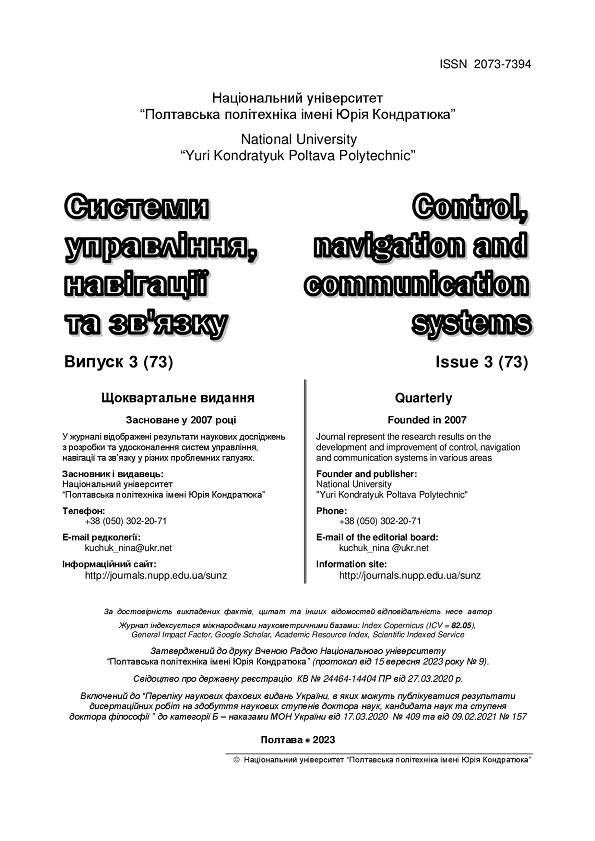METHOD OF IDENTIFYING THE STATE OF A COMPUTER SYSTEM BASED ON ENSEMBLE CLASSIFIERS WITH AN IMPROVED VOTING PROCEDURE
DOI:
https://doi.org/10.26906/SUNZ.2023.3.079Keywords:
classification, machine learning, ensembles, begging, weighted voting, ensemble pruning, accuracy, performanceAbstract
The object of research is the process of identifying the state of the computer system. The subject of research is the methods of identifying the state of CS. The purpose of research is to improve the quality and performance of ensemble classifiers by optimizing the voting procedure. Methods used: machine learning methods, ensemble classifiers, ensemble pruning method, weighted adaptive voting procedure. The results were obtained: an ensemble method of identification of computer systems based on the begging meta-algorithm with a special procedure for reducing the number of basic classifiers and their ranking was developed. The effectiveness of various approaches to pruning basic classifiers based on decision trees to improve the quality of the meta-algorithm was investigated. Different types of methods for calculating weighting coefficients for the implementation of weighted voting using various quality metrics are considered. Experimental studies allowed to evaluate the considered approaches separately, and also confirmed the effectiveness of their integrated use. Conclusions. Based on the results of the research, an improved ensemble classifier for identifying the state of the computer system based on the begging meta-algorithm is proposed, which differs from the known ones in the complex use of pruning methods of basic ensemble classifiers and the use of the adaptive weighted voting procedure. Due to the improvement of the classifier, it was possible to increase its accuracy to 2.5%. Prospects for further research may be the selection and adjustment of basic classifiers using various machine learning methods.Downloads
References
Sathiya Devi, S., Rajakumar, R. (2021). Network Intrusion Detection Using Cross-Bagging-Based Stacking Model. In: Pandian, A., Fernando, X., Islam, S.M.S. (eds) Computer Networks, Big Data and IoT. Lecture Notes on Data Engineering and Communications Technologies, vol 66. Springer, Singapore. https://doi.org/10.1007/978-981-16-0965-7_58
Челак В. В. Розробка методу ідентифікації стану комп'ютерної системи на основі нечітких дерев рішень / С.Ю. Гавриленко та В.В. Челак // Системи управління, навігації та зв’язку Випуск 1 (71).– Полтава, Україна, 2023.– с. 78-83. https://doi.org/10.26906/SUNZ.2023.1
Andrea Campagner, Davide Ciucci, Federico Cabitza, Aggregation models in ensemble learning: A large-scale comparison, Information Fusion, Volume 90, 2023, pp. 241-252. https://doi.org/10.1016/j.inffus.2022.09.015
O. Hornostal and S. Gavrylenko, “Development of a method for identification of the state of computer systems based on bagging classifiers”, A.I.S., vol. 5, no. 4, pp. 5–9, Dec. 2021. https://doi.org/10.20998/2522-9052.2021.4.01
O. Hornostal, S. Gavrylenko and V. Chelak "Ensemble Approach Based on Bagging and Boosting for Identification the Computer System State," 2021 XXXI International Scientific Symposium Metrology and Metrology Assurance (MMA), Sozopol, Bulgaria, 2021, pp. 1-7. https://doi.org/10.1109/MMA52675.2021.9610949
J. A. Sáez and J. L. Romero-Béjar, “On the Suitability of Bagging-Based Ensembles with Borderline Label Noise,” Mathematics, vol. 10, no. 11, p. 1892, Jun. 2022. https://doi.org/10.3390/math10111892
A. Dogan and D. Birant, "A Weighted Majority Voting Ensemble Approach for Classification," 2019 4th International Conference on Computer Science and Engineering (UBMK), Samsun, Turkey, 2019, pp. 1-6. https://doi.org/10.1109/UBMK.2019.8907028
Pinto, F., Soares, C., Mendes-Moreira, J. (2015). Pruning Bagging Ensembles with Metalearning. In: Schwenker, F., Roli, F., Kittler, J. (eds) Multiple Classifier Systems. MCS 2015. Lecture Notes in Computer Science, vol 9132. Springer, Cham. https://doi.org/10.1007/978-3-319-20248-8_6
Sannasi Chakravarthy, S.R., Rajaguru, H. (2022). Ensemble-Based Weighted Voting Approach for the Early Diagnosis of Diabetes Mellitus. In: Karrupusamy, P., Balas, V.E., Shi, Y. (eds) Sustainable Comm. Networks and Application. Lecture Notes on Data Engineering and Comm. Technologies, vol 93. Springer, Singapore. https://doi.org/10.1007/978-981-16-6605-6_33
Wenyu Zhang, Dongqi Yang, Shuai Zhang, A new hybrid ensemble model with voting-based outlier detection and balanced sampling for credit scoring, Expert Systems with Applications, Volume 174, 2021. https://doi.org/10.1016/j.eswa.2021.114744
Li, D., Zhang, Z. & Wen, G. Classifier subset selection based on classifier representation and clustering ensemble. Appl Intell (2023). https://doi.org/10.1007/s10489-023-04572-x
S. Kwak and H. Kim, “Comparison of ensemble pruning methods using Lasso-bagging and WAVE-bagging,” Journal of the Korean Data and Information Science Society, vol. 25, no. 6. Korean Data and Information Science Society, pp. 1371–1383, 2014. https://doi.org/10.7465/jkdi.2014.25.6.1371
George D.C. Cavalcanti, Luiz S. Oliveira, Thiago J.M. Moura, Guilherme V. Carvalho, Combining diversity measures for ensemble pruning, Pattern Recognition Letters, Volume 74, pp. 38-45, 2016. https://doi.org/10.1016/j.patrec.2016.01.029




